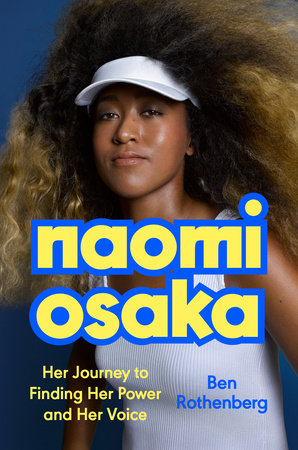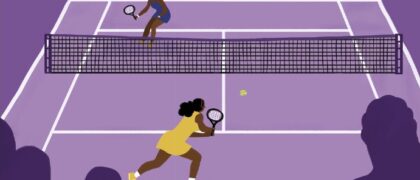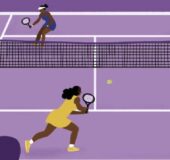One
Paradise
In soft Spanish pinks and bright, buttery yellows, the banners and graphics emblazoned around the Indian Wells Tennis Garden proclaim each visitor's ascendance to a higher plane: "welcome to tennis paradise."
Indian Wells, a small resort community in the California desert just southeast of Palm Springs, hosts the annual tennis tournament, which has grown into the world's largest outside the four Grand Slam events, luring in the world's best players for a two-week tournament with the paired promises of perfect weather and a prize money purse over $9 million.
Ever since Larry Ellison, the billionaire founder of the software company Oracle, bought the tournament in 2009, the most heavenly delights in "Tennis Paradise" haven't come cheap for attendees. The most expensive ticket packages inside the stadium can cost upwards of $13,000 per seat for the tournament. At the Nobu restaurant overlooking the court of Stadium 2, the lobster salad with grilled shiitake mushrooms goes for $65 and the grilled Japanese A5 Wagyu steak runs $38 per ounce, at a minimum of four ounces; either pairs nicely with the Rémy Martin Louis XIII Grande Champagne cognac for $350 a glass.
Hundreds of thousands drive over from Los Angeles or flock in on flights from colder parts of North America each March to pose around the grounds for carefully composed Instagram pictures in front of mountains and palm trees beneath the vivid, no-filter cerulean sky. For them, it's all a small price to pay to make other people jealous as they momentarily scroll past your life. Because at Indian Wells, where you're told every which way you turn that you're in paradise, your life is going to look just perfect from a distance.
There is, it can be easy to forget, another class of attendees at Indian Wells who aren’t there to eat, drink, and be seen: the people who are actually there for the tennis. In addition to its stadiums, Indian Wells has become a destination for ardent tennis fans hoping to see the sport’s biggest stars up close and personal on the practice courts. With a grounds pass that can be bought for as little as $20, a fan with a plan can stake out a spot to see his or her favorite players warming up for their matches in a relaxed, intimate environment. For the most eager and outgoing, smart positioning near the exits of the courts can yield opportunities for autographs and selfies if the player is willing.
On Saturday, March 12, 2022, the twenty-four-year-old tennis player Naomi Osaka is scheduled to have her pre-match practice at 5:00 p.m. on Practice Court 1. Naomi is practicing late because she is on late: her second-round match against Russia's Veronika Kudermetova is scheduled to be the second match of the Saturday evening session, a slot that is a bit beyond prime time at Indian Wells but a showcase Sunday afternoon slot for the television audience in Japan.
There are a few hundred grandstand seats around Practice Court 1; in the minutes before she is scheduled to arrive, every seat is filled. Another row of people stands behind the back row on the side to peer over the seated spectators. Soon, a second row stands behind the first standing row. Soon again, a third row of people gathers to stand on tiptoes behind the first two rows and peers through whatever gaps there might be for a glimpse of the four-time major champion.
As the clock ticks past 5:00 p.m., Naomi's name and face appear on a courtside electronic display board, but Naomi herself is nowhere to be seen. "Is she coming?" asks one boy at 5:06 p.m. As the clock ticks past 5:10 p.m., kids holding the jumbo tennis balls used to collect autographs appear increasingly antsy. "Maybe she's waiting so there's a bigger reception for her when she comes," one man suggests. Around 5:20 p.m., those who had turned their backs to the court to look toward the players' patio spot Naomi emerging at last. But instead of turning left to Practice Court 1, she and her team walk straight across the field to empty Practice Court 7. Only a handful of the crowd at Practice Court 1 spot Naomi make her detour; they break off surreptitiously from the larger crowd so as not to cause a stampede that might cost them prime seating at the smaller, secluded court.
Naomi arrives with her team in tow: Wim Fissette, the forty-one-year-old Belgian who had been her coach for the last two and a half years, her strength and conditioning coach Yutaka Nakamura, her physiotherapist Natsuko "Nana" Mogi, and her young Belgian hitting partner, Seppe Cuypers. Naomi is dressed entirely in her favorite color, black. Above black leggings that end just below her knees, she wears a black T-shirt brightened only by the white logos of three of her primary sponsors: Nike, the software company Workday, and the skincare company Kinlò. She wears a black cap on her head that has her Nike-made "NO" monogram in white on the front, and the red-and-yellow logo of Mastercard, another major sponsor of hers, on the side.
As a handful of fans slide into the dozens of empty seats above and behind the court, Naomi begins a jogging warm-up, which both Nakamura and Mogi do alongside her, clapping and laughing. After stretching with a medicine ball, Naomi picks up her racquet and walks out onto the court, across the net from Cuypers. As the two begin by standing close to the net and hitting softly, Naomi holds the racquet only with her left hand, laughing and doing a pirouette between shots. The next day, a fan will upload a video of these moments with a soundtrack of bouncy Japanese pop music and the caption "The world's cutest girl who loves practice."
Slowly and subtly, Naomi and Cuypers, a twenty-three-year-old whose Association of Tennis Professionals (ATP) ranking peaked at 1,449th, have each backed away from the net while hitting and are standing on opposite baselines of the court, ramping up to whacking the ball back and forth at full strength. The pops from Naomi's crisp, clean contact with the ball against the center of her polyester racquet strings can be heard clearly despite the growing crowd, which has by now located her at Practice Court 7; her fans are resolutely respectful and even reverent, aware that they are watching a professional at work. But the work looks fun from the stands: even as she is crushing forehands, Naomi is still cracking smiles. When a ball skips off the net cord and over Cuypers's flailing racquet, she teasingly says, "Embarrassing, embarrassing!" When she nets a simple volley, she squeaks a quick "Sorry!" to Cuypers.
Naomi doesn't acknowledge the gathering crowd behind the court as she rallies with Cuypers, but when she switches sides of the court between drills a young fan says "Hi, Naomi!" as she nears. She looks up, smiles, and waves.
After a few minutes of serve practice, Fissette approaches Naomi and they begin to discuss specific patterns to employ against Kudermetova in the upcoming match. "First serves can go anywhere; second serves?" Naomi asks, and Fissette replies with a soft voice to lower the volume of the conversation below audience audibility. Fissette is collaborative in his conversations on court, listening rather than just lecturing. Naomi is deferential by nature, but Fissette doesn't exploit that to dominate their conversations, like many coaches would.
The practice wraps with Fissette softly floating several balls to Naomi for her to crush with full power, ending the brief session on an emphatic, confidence-building note. After Naomi finishes with the biggest bangs, like a fireworks display might, the hundreds watching cheer softly but warmly. After just twenty minutes on court, Naomi and her team are done and begin to pack up their bags. Naomi's older sister, Mari, walks on court as the team is wrapping up, and Naomi playfully pokes at her with a water bottle, which Mari bats away.
Mari Osaka used to play tennis, too, but not anymore. Now it's just Naomi.
As Naomi's team leaves the court and turns to walk back toward the locker room, Naomi drops her bag and jogs in the opposite direction, toward a cluster of fans who have amassed behind a rope cordoning off the walkway on the far corner of the court, so she can sign autographs and pose for selfies for everyone waiting there. When she finishes with that group, instead of walking the straight line back to the locker room, Naomi runs to the far corner of the field between the practice courts and locker room, to start at the far end of the line and work her way down the dozens of fans waiting for her along the fence. Naomi smiles with her lips closed and holds up two fingers-a typical Japanese pose-for each photo. Several times, when a less tech-savvy older fan struggles with the camera app on their phone, Naomi will take the phone from them, tap the necessary buttons, and frame and snap the selfie herself before handing the phone back to them. Judging by their reactions, having their phones handled momentarily by a star was not an intrusion but a thrill.
As Naomi works her way down the line, satisfied fans peel off the fence and giddily compare their selfies with one another. "No pushing!" a security guard shouts as Naomi reaches the end of the fence.
Unlike athletes in other sports who can meticulously plan their schedule each day of a competition, tennis players often have to deal with uncertain start times because of the variable lengths of preceding matches, sitting and stewing as they wait their turn to play. In this Saturday evening session, the first match goes the distance; Stefanos Tsitsipas needs more than two and a half hours to complete a win over Jack Sock in a third-set tiebreak. By the time Tsitsipas has finished his on-court interview and left the court, Naomi has been waiting for nearly an hour, most of it alone with her thoughts in the locker room. A tournament manager then tells her that it is time for her match. She is driven in a golf cart from the locker room to the court entrance.
With her white Beats by Dre headphones stretched over her black Nike visor and covering her ears, Naomi walks onto the Stadium 1 court.
"Ladies and gentlemen, she's our 2018 champion!" tournament emcee Andrew Krasny announces through the speakers on all sides. "Please welcome: Naomi Osaka!"
In fact, before her 2018 title at Indian Wells, the lucrative tournament that had earned the unofficial title of the “Fifth Slam,” Naomi Osaka had never won an official professional tournament anywhere, even at the lowest levels of the sport. To earn the trophy and the $1,340,860 in prize money at the lucrative tournament, Naomi had to win seven matches-the same number it takes to win a Grand Slam title. Just twenty years old and ranked 44th in the world, Naomi ran a gauntlet that included some of the sport’s biggest names: five-time major champion Maria Sharapova in the first round, former No. 2 Agnieszka Radwańska in the second round, former No. 1 Karolína Plíšková in the quarterfinals, and then No. 1 Simona Halep in the semifinals. After beating all four of those established stars in straight sets, Naomi finished with another straight-set win over fellow twenty-year-old rising star Daria Kasatkina in the final.
But more than Naomi's awe-striking power and poise in her 6-3, 6-2 win over Kasatkina, the lasting memory from Naomi's first final was how unprepared she seemed for the trophy ceremony that followed, where she had to address the audience in the stadium and watching on television in a customary champion's acceptance speech. Naomi fidgeted with her jacket collar and hesitated about whether or not she should touch the microphone.
"Um, hello?" Naomi said with a giggle. "Um. Hi, I'm Nao-Oh, okay, never mind." As she neared the close of her remarks, which never got more fluent, Naomi declared herself a failure: "This is probably going to be, like, the worst acceptance speech of all time."
But though she had sputtered and swerved and stalled throughout-or, perhaps, because she had-the crowd was thoroughly charmed by Naomi. Even billionaire tournament owner Ellison, stiff-faced in the front row, had cracked a smile by the end of Naomi's speech. She had been awkward, yes, but in a way that was seen as eminently relatable and unpretentious, particularly by those close to her Gen Z age.
That day at Indian Wells made clear to a broader public three things about Naomi that close observers of hers had known for years:
Naomi Osaka was one of the best tennis players in the world.
Naomi Osaka was different.
Naomi Osaka was cool.
On a stage that primarily showcased polished and prepackaged athletes, Naomi was a winner who offered something different, something authentic. From the stands and in front of televisions around the world, new legions of fans-and sponsors-were taking notice, and they would continue to take more notice throughout the year.
"This place definitely holds a lot of really good memories for me, and it definitely did propel my confidence," Naomi said in her pretournament press conference at Indian Wells in 2022.
Naomi immediately followed up her win at Indian Wells in 2018 by beating Serena Williams in their first match in Miami days later. Six months after that, Naomi again beat Serena, this time in the final of the U.S. Open for her first major title. By March 2022, Naomi's major title haul was four, the most held by any active player on the women's tour not named Williams. She had a diverse and growing portfolio of off-court holdings as well, including an equity stake in the burgeoning cryptocurrency website FTX. Within months, Naomi started her own sports management and media production companies. With over $50 million a year in endorsements, Naomi seems well on her way to her goal of becoming the first billionaire female athlete.
Over those four years, the highs had been exceptionally high for Naomi Osaka. But her ranking had fallen considerably by this Saturday night. Remarkably, considering the four major titles to her name were more than those of any other player in the draw, Naomi had arrived at Indian Wells with a ranking of 78th, so diminished that she only squeaked into the draw just days before the tournament began once several higher-ranked players had withdrawn from the field.
It was more than just being able to get into tournaments: Naomi admitted at Indian Wells that she often wrapped up her self-worth with her ranking. "For me, that was everything," Naomi said at Indian Wells. "And I can't be bold enough to say I've completely changed that mindset. . . . Like, if I'm valuable to someone's life, I feel like they treat me better or something like that, you know?" she said.
Copyright © 2024 by Ben Rothenberg. All rights reserved. No part of this excerpt may be reproduced or reprinted without permission in writing from the publisher.







